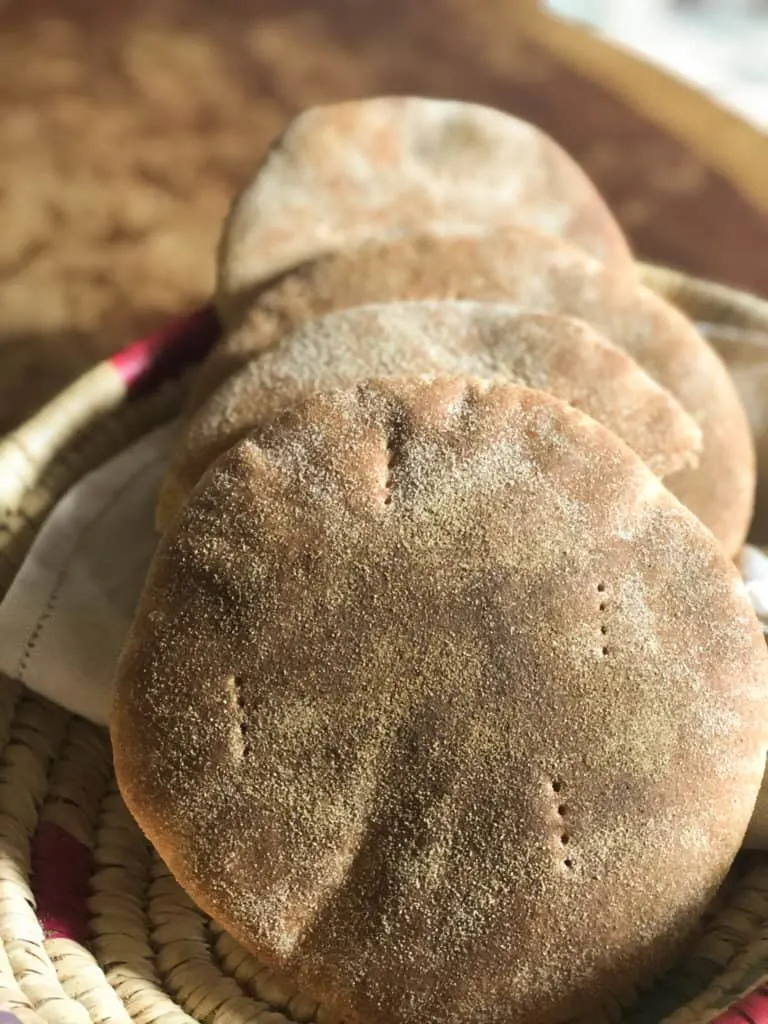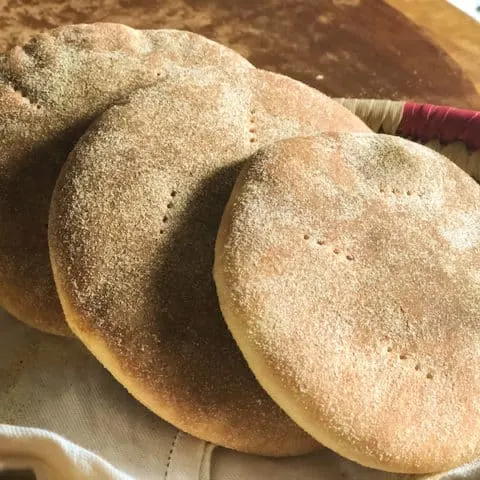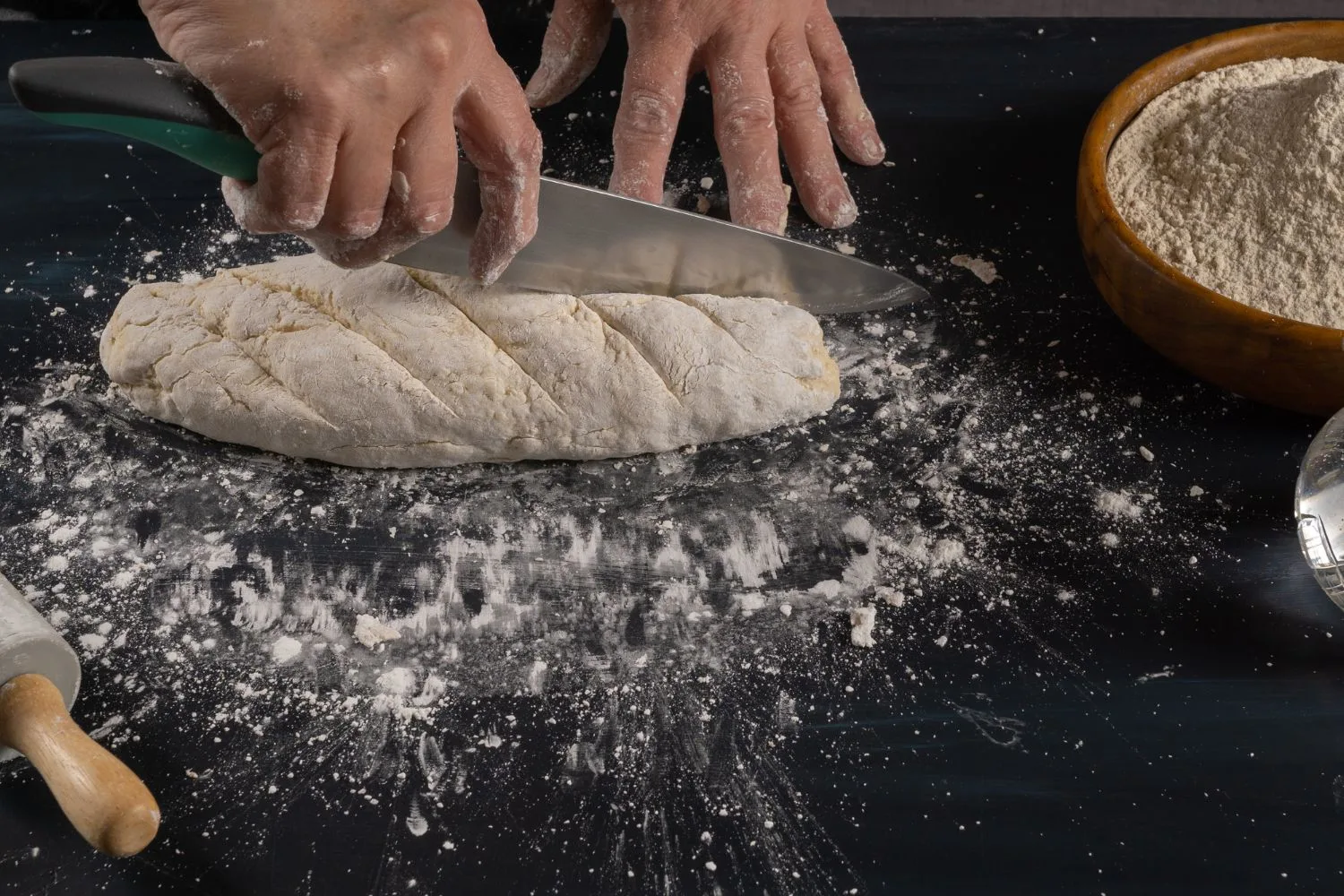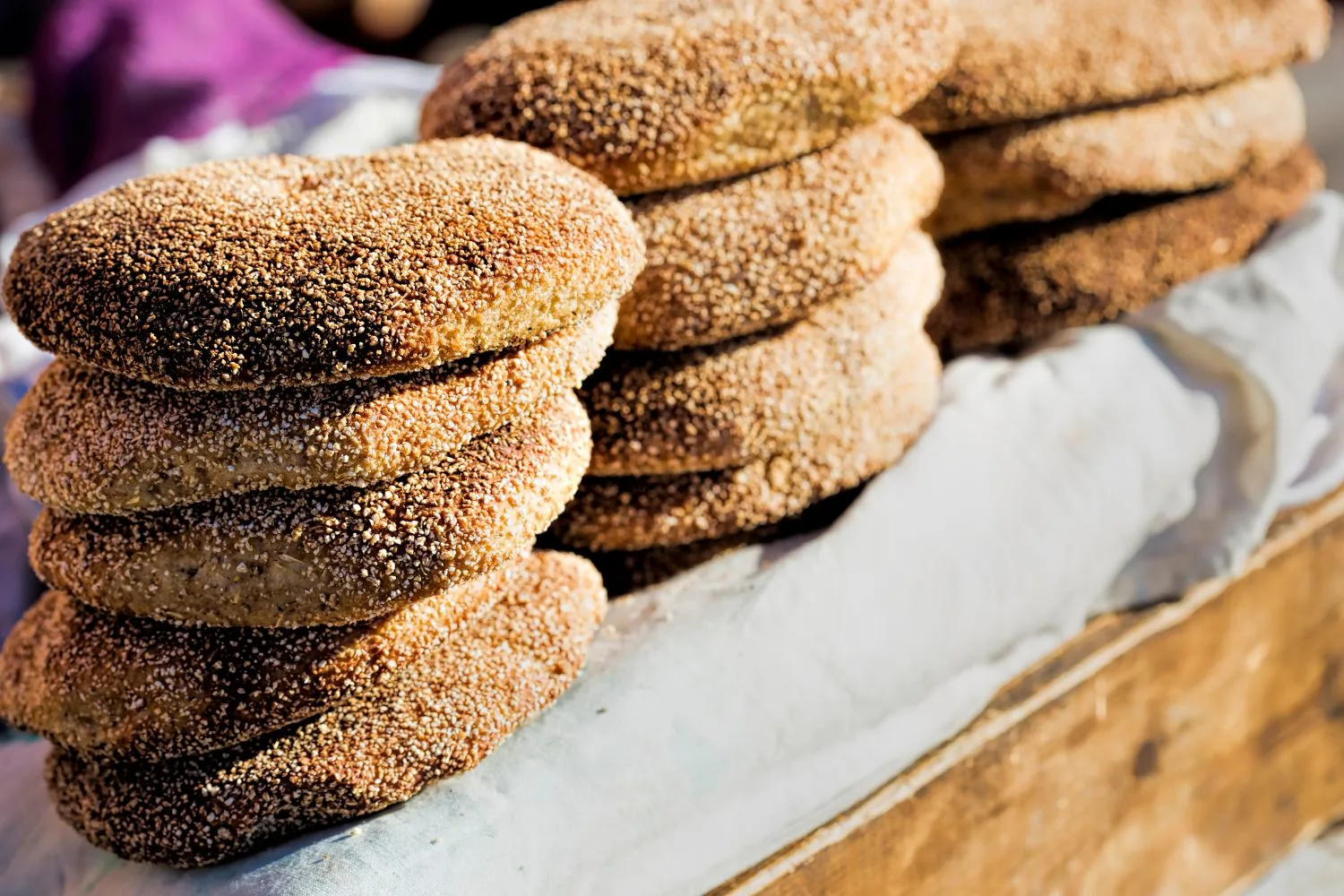I don’t know if there’s anything more Moroccan than a round loaf of bread.
Nope. There’s not.
Let’s just say no one in Morocco is going to be doing the Paleo diet anytime soon. Bread is so prevalent and ingrained (haha ingrained) in Moroccan culture my husband can not eat a meal without it. And before you say wait, well he CAN he just doesn’t want to – no he really can not.
I used to make Moroccan bread almost every day when we got married – kneading it and all. Then we got a Kitchen Aid stand mixer and that made it a whole lot easier.

How to Make Moroccan Khobz

Traditional Moroccan Khobz
This is a recipe for traditional Moroccan round bread, also known as khobz. My recipe is made using only white flour however you can add in wheat flour as well. You will need to adjust the water levels a bit.
Ingredients
- 4c and a little extra white flour - do not use self rising flour! ( you can also use wheat or half of each flour)
- 2 c warm water
- 1 Tbsp active dry yeast (or 1 pkg of Red Star or like brand)
- 2 tsp salt
- 1 tsp sugar
Instructions
- In a small bowl add yeast, sugar and 1c warm water. Mix well and allow yeast to bubble.
- In a large bowl add flour and salt. After yeast/water mixture begins to bubble pour into bowl with flour. Begin combining flour and water.
- Have another cup of warm water to the side and add slowly to flour mixture. You may not use the entire cup.
- Continue combining flour and water until you can form a ball. At this point it should be a bit sticky.
- Pour vegetable oil into your hands and proceeds to work it into the dough. Again you may not use a full 1/4 cup.
- Most of the dough should come off of your hands and combine into the dough that will be elastic but no longer sticky.
- Knead for 8-10 minutes. You can do this by hand or in a mixer - if using a mixer reduce the time to approximately 5 minutes.
- Oil the ball and the bowl and cover. Allow to rest 15 minutes.
- Divide dough into 2-3 portions depending on the size of the bread you would like.
- Using the divided pieces form 2-3 smaller balls.
- Sprinkle flour on a board or counter-top and begin to push down the ball beginning in the center, similar to how you would form a pizza crust. Moroccan bread is traditionally in a circle shape however whatever shape you make it will not really matter!
- The dough should be about 1/4" thick and even on all sides.
- Wrap in a towel and continue for the remainder of the portions.
- Allow dough to rise about 45 minutes. Preheat the over to 400-425F.
- Once dough has risen prick with a from several times and place on a cookie sheet or baking stone into the oven.
- Cook until it begins to brown and makes a hallow sound when tapped - about 18-20 minutes. Remove from oven and allow to cool.
When we moved to Northern Virginia there was so much good bread at a cheap price that we would freeze and thaw bread instead of making it. I spent 2 1/2 years doing that and I really didn’t miss making bread! Now that we moved back to Wisconsin the kind of bread we like is much more expensive and not the same quality so it seems like I will be going back to baking bread again. (this original recipe is from 2009 – we now live in Morocco!)
The fun thing about this bread is that it’s pretty forgiving. You can use different kinds of flours, mixtures of flours, rising time and making it into different shapes. Traditionally it is made into a round and there is some technique to making it the authentic way.
What is Khobz?
Khobz, broadly translating to “bread” in Arabic, is a staple of Moroccan cuisine. This traditional loaf is characterized by its crusty exterior and soft, chewy interior, much like a rustic sourdough. While the basic recipe remains consistent, regional variations exist; for instance, in some areas, Khobz is made with whole wheat flour or blended with semolina for added texture.
Cultural significance is deeply ingrained in Khobz, often being served during significant celebrations, family gatherings, and everyday meals. Every Moroccan household has its unique recipe passed down through generations, making it a source of pride and nostalgia. Alongside Khobz, Moroccan coffee {Nous Nous} also plays a vital role in these social occasions, embodying warmth and hospitality that define Moroccan culture.
Ingredients Needed

Making traditional Khobz requires simple ingredients that are easily accessible:
- Flour: You can use all-purpose flour or semolina for a different texture.
- Water: Essential for hydrating the flour and activating the yeast.
- Salt: Enhances flavor and improves the texture of the bread.
- Yeast: Fresh or active dry yeast can be used to help the dough rise.
- Optional Additives: You might consider adding seeds (like sesame), dried herbs, or spices (like cumin) for extra flavor.
Tips on Selecting the Best Ingredients
Choose high-quality flour for optimal results. If using active dry yeast, make sure it is fresh and properly stored. A pinch of good sea salt can elevate your bread’s taste, while seeds add both nutrition and crunch.
Tips for Making Perfect Khobz
- Common Mistakes to Avoid. Over-kneading can lead to tough bread, while under-kneading results in a dense loaf. Always give your dough enough time to rise. Be mindful of the temperature of your ingredients; using cold water can slow down yeast activation, affecting your dough’s rise. Using too much flour can also create a dry texture, so measure your ingredients carefully for the best results. Lastly, ensure your baking surface is well-prepared to prevent sticking and achieve that perfect crust.
- Variations to Try. Experimenting with spices or using whole grain flour can enhance flavor and nutrition. Also consider adding different seeds for texture. You can also incorporate herbs like rosemary or thyme for a fragrant twist. For a touch of sweetness, try mixing in a small amount of honey or date syrup into the dough. Don’t be afraid to play with the fermentation time, as a longer rise can develop deeper flavors in your khobz.
- Storage Tips for Freshness. Wrap leftover Khobz in a kitchen towel and store in a bread box or plastic bag to keep it soft. For longer storage, consider freezing Khobz by placing it in an airtight container or freezer bag, which will preserve its texture and flavor. When you’re ready to enjoy it again, simply reheat it in the oven or on a skillet to restore its original softness. Additionally, adding a slice of apple or a small piece of bread to the storage container can help maintain moisture levels and prevent the Khobz from drying out.
Serving Khobz
Khobz pairs beautifully with traditional Moroccan dishes, such as tagines, salads, or dips like hummus and zaalouk. Using leftover Khobz to make a flavorful bread pudding or croutons adds another layer of creativity to your meals.

Other Bread Recipes to Try
Explore the rich and diverse world of Moroccan cuisine with our collection of delightful bread recipes that go beyond the classics. These unique breads capture the essence of Moroccan culture and flavors. From fluffy khobz to fragrant msemmen, each recipe invites you to bring a taste of Morocco into your kitchen.
- Moroccan Flat Bread Recipe
- Batbout – Moroccan Pita Bread
- Rghaif – Stuffed Moroccan Msemmen
- Moroccan Jewish Moufletta
- Rghaif Shema – Berber Pizza
Khobz is more than just bread; it’s a testament to Moroccan culture and hospitality. Making it at home can connect you with the essence of Morocco. So why not roll up your sleeves and try your hand at crafting this delicious bread?

s
Friday 30th of August 2024
AsSalamuAlaykum,
Can I use corn flour (not corn starch), eggs, oil and water to make a basic allergy friendly bread?
Amanda Mouttaki
Sunday 1st of September 2024
It won't get the same result. I do have a gluten free version of Moroccan bread here - https://marocmama.com/gluten-free-moroccan-style-round-bread/
Mary
Saturday 22nd of June 2024
What does 'c' stand for in the measurement of flour? I assumed it might be cups, but cups can't be used to measure flour as it is is way too inaccurate. 1 cup of lightly packed flour is a totally different quantity to 1 cup of packed flour. Flour has to be weighted to be sure of accuracy. Can you tell me how many ounces, or grams, of flour you are using.
Amanda Mouttaki
Sunday 23rd of June 2024
Hi Mary. Truthfully in Morocco it's not weighed nor measured. It's just put in to the eye and then more flour or water added as you go. I've always used rough cups to measure and then adjusted based on the dough but I'll try and rework this recipe with some weights to help other readers out.
Robert
Friday 22nd of December 2023
Hi Amanda, Can you use a sourdough starter instead of the yeast. I have tried but it seems to not rise at all and create air pockets
Amanda Mouttaki
Friday 22nd of December 2023
I've never tried it with sourdough but you could give it a shot!
Courtney
Sunday 15th of October 2023
I just made this and it came out hard as a rock. Not burnt either. Don’t know what I did wrong and I followed the recipe.
Amanda Mouttaki
Wednesday 18th of October 2023
i'm sorry it didn't turn out for you. My guess is that the dough needs to be kneaded longer (it's often a culprit), it's also possible there was more water needed. Bread can be tricky depending on elevation, the actual type of wheat, water and several other factors.
Stacey Finckbone
Wednesday 22nd of February 2023
I will be grateful for this when my Moroccan husband gets here in the states. I have tried to find bread close to what they have there but can’t. These is also a dish I would love to know how to make. Was goat meat like a bone in roast, had prunes and onions and they put hard boiled eggs when it was done. It was one of my favorites when we were in Saidia.
Jonelle Hockenberry
Saturday 26th of August 2023
@Stacey Finckbone, this is an absolute favorite of mine too.
Amanda Mouttaki
Friday 10th of March 2023
This is the base recipe for what you likely had. Sometimes boiled eggs are added on top and it's made with goat too - https://marocmama.com/beef-tajine-with-prunes/